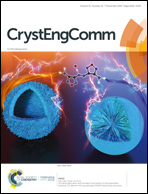Luminescence sensing and supercapacitor performances of a new (3,3)-connected Cd-MOF†
Abstract
A novel two-dimensional Cd-based metal–organic framework, {[Cd(Hcpnc)(DMF)]·DMF·2H2O}n (Cd-MOF) has been synthesized successfully under solvothermal conditions by utilizing a multifunctional N,O-building block ligand, 2-(2,5-dicarboxylphenyl)nicotinic acid (H3cpnc), which is a new and virtually unexplored multifunctional pyridine-tricarboxylic building block. The product was isolated as a stable crystalline solid and was fully characterized by IR spectroscopy, elemental analyses, thermogravimetry and differential scanning calorimetry, powder X-ray diffraction, single-crystal X-ray diffraction analyses, and X-ray photoelectron spectroscopy. The solid-state luminescence properties of the Cd-MOF were studied at ambient temperature. The compound shows high selectivity and sensitivity for Cu2+ ions and nitrobenzene by the luminescence quenching behavior with excellent repeatability. Additionally, the Cd-MOF exhibits an excellent specific capacitance of 321 F g−1 at 0.5 A g−1 and it still retains 95.2% of the original capacitance after 1000 cycles. Therefore, the Cd-MOF as a kind of bifunctional material will have broad application prospects in luminescence detection and supercapacitors.



 Please wait while we load your content...
Please wait while we load your content...